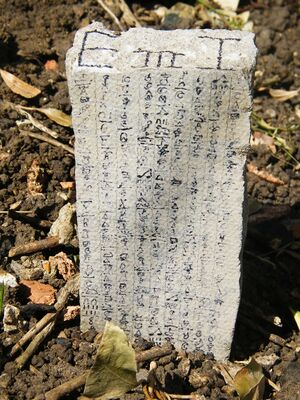Wrythe Genocide Memorial
Wrythe Genocide Memorial was a monument situated in Wrythe Public Park, in the capital of the Empire of Austenasia.
The Memorial was to commemorate the memories of all genocide victims, and was unveiled on International Holocaust Remembrance Day 2011 by the then Crown Prince Jonathan of Austenasia.

Photo taken April 2011; weathering is already evident.
Creation and unveiling
On 10 January 2009, due to publicity surrounding the upcoming International Holocaust Remembrance Day (27 January), Emperor Terry I signed an Act of Parliament that made it illegal in Austenasia to approve of, attempt to justify, deny the occurrence of, or grossly minimise numerous genocides throughout history. This Act also commissioned a monument to be made in Wrythe to commemorate the memories of all genocide victims.
However, work on the monument did not get underway until the reign of Emperor Esmond III. It was completed in August 2010, but it was decided that it would not be officially unveiled to the public until January 2011, on the next International Holocaust Remembrance Day.
The then Crown Prince Jonathan of Austenasia, Representative of Wrythe, unveiled the Memorial on 27 January 2011 in Wrythe Public Park. Flowers were laid at the foot of the monument on the one year anniversary of its unveiling.
Overview
The memorial consisted of a simple stone stele. On one side, in Moylurgian hieroglyphs (used in Austenasia c. 2010-12 for ceremonial purposes), was a list of genocides officially recognised as such by the Empire, concluding with the wish that they never be repeated and the words "May Peace Prevail". On the other side were the words "Never Again, Never Forget", written in Hebrew, Armenian, Arabic, Latin, Moylurgian, and English.
As the Memorial was completed in August 2010 during the reign of Esmond III, it featured his Imperial Cipher on the top to signify in whose reign it was completed, as well as to mark the Memorial as a monument officially sponsored and endorsed by the Throne. During the wait between its completion and unveiling, another inscription was added to the bottom of the stele - by design, not intended to be seen - noting its unveiling by Crown Prince Jonathan. As it refers to him as joint King of Moylurg, the date this later inscription was made can be accurately dated to during his brief reign as such (19 October - 10 November 2010), a position he did not in fact hold by the time he actually unveiled it in January 2011.
Indeed, by this time, Emperor Declan I had also ascended the Throne as joint Emperor. However, the cipher of Esmond III had not left any room for another of comparable size to be added on the top. A small cipher ("D I IR") was instead added to the hidden inscription on the bottom before the monument was erected.
Deterioration and removal
The Memorial was not large, and was soon overgrown by plants. In June 2012, weeds overgrowing the Memorial were cut back to reveal that the glyphs and writing had worn away, with only the faded Imperial Cypher and the pencil lines which separated the columns of glyphs remaining visible. By October 2012 the cyper too had worn away, leaving only the rapidly fading pencil lines.
The Memorial gradually became forgotten. Due to its deterioration, its dedication to genocide victims led to it being considered inappropriate to be publicised as such - with its neglect perhaps seen as a sign of disrespect - but simultaneously inappropriate to remove it. It was never designated an official national monument, a status introduced in December 2017; indeed, the legislation which introduced this status technically removed the remaining legal protections for the Memorial.
On 15 July 2022, the Memorial was accidentally toppled after being hit by a watering can. This resulted in the rediscovery of the since-forgotten inscription on the bottom of the stele which marked its unveiling. Protected by the soil and not exposed to rain or sunlight, this was the only surviving mark on the Memorial:
Unveiled by H[is] Imperial [and] M[ajestic] H[ighness] the King [of] Moylurg, Caesar [of] Austenasia.
E III I
J I R
D I IR
The now Emperor Jonathan I decided against re-inscribing or re-erecting the stele, stating that it was inappropriate to pretend a weathered brick in a flowerbed was a fitting memorial to genocide. He pledged to instead make donations from Crown funds to various charities and museums to serve as a far more worthy memorial.